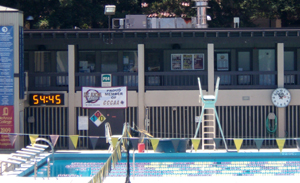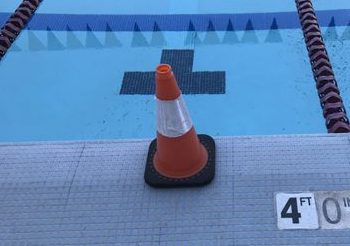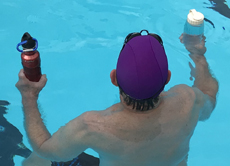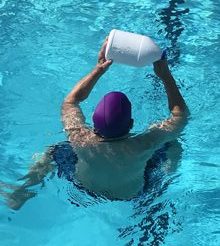A previous dean added this journal writing assignment to the curriculum for all De Anza College swim classes.
“Establish a personal practice workout journal to compare pre- and post skill acquisition.”
“Establish a personal practice journal to compare cardiovascular fitness acquisition and individual workouts.”
Previous students in my swim classes decided the length of 1,000 word minimum, (total 1,000 words, not 1,000 words per day).
Some students write over 2,000 words.
Part of your grade will be to keep a personal/practice journal in which you will compare pre- and post skill acquisition and possibly cardiovascular fitness acquisition and individual workouts. It should be about workouts done in swim class, (during class or during office hours after class people sometimes attend for extra work / makeups) not your workouts outside of class time.
Keep a written record of your experiences and progress in the class.
Start with an assessment of your skills before class started. You can copy the Canvas website first day of class assignment of the survey of your current skills and personal goals for the class and then include details.
Then add: What did you accomplish each day?
What was hard,
what was easy,
what was new,
which techniques were best for you?
“I was finally able to . . . because . . . ”
You will learn a lot from it (and your instructor will learn as well).
It should have a few paragraphs for each session of class, written as the class goes along.
(A few pages of notes put together quickly at the last minute or a calendar of events with no discussion of your skills and improvements will not earn credit.)
You will find a date at Canvas to turn it in. (You will not submit work weekly, instead you will submit all of your workout journal near the end of the quarter.)
Keep track of any improvements in your toe-point.
For example, one student wrote:
“…In my first entry I said that my toe point was five inches from the ground, today I measured it and it was four and a third of an inch from the ground. I’m really surprised and happy about the improvement . . . my toe point has improved from five inches, to four and a third, to finally four inches. . . After reading up on the toe point on Marys’ website, a better toe point means better ankle flexibility which will greatly improve your swimming. I hope that when I begin swimming next semester my toe point will improve to three inches.”
Keep a record of how many freestyle arm pulls it takes you to go across the width of the pool at the start of the quarter and as we go along.
For example, a student wrote:
“Beginning of quarter: My average crossing the pool width-wise is 24 seconds, and it takes me 24 strokes.
End of quarter: It takes me 23 seconds to cross the pool width with only 15 strokes.”
You can make note of each of your distances on the Cooper 12 minute swims
and speeds on any timed swims for any stroke (you can regularly do 25 yard and or 50 or 100 yard timed tests).
For example, a student wrote:
“Fall quarter I made an astonishing discovery: my time for 25 yards freestyle was forty seconds, which is 20 seconds less than it was during the summer quarter.”
There are two big time-clocks at each end of the pool so you can look and note the time as you leave the side of the pool, and see how you did when you get to the far side for a 25 yard swim, for example.
In our swim classes, people time themselves in 25 and 50 yard swims. College and Olympic swim teams don’t compete in 25 yard or 50 yard swims so it is difficult to compare to them, but Masters Swimmers do.
Here are some recent records in 25 yard freestyle for men: 9.85 seconds (24 years old), 10.59 seconds (31 years old), 11.09 seconds (49 years old), 11.31 seconds (58 years old), 11.41 seconds) (60 years old), 11.43 seconds (58 years old), 11.44 seconds (39 years old), 11.47 seconds ( 32 years old), 11.72 seconds ( 60 years old) 11.75 seconds (27 years old).
Here are some recent records in 25 yard freestyle for women: 12.75 seconds (40 years old), 12.82 seconds ( 31 years old), 13.06 seconds (37 years old), 13.07 seconds (29 years old), 13.26 seconds (30 years old), 13.39 seconds (41 years old), 13.75 seconds (40 years old), 13.76 seconds (27 years old), 14.07 seconds (22 years old).
Here are some recent records in 50 yard freestyle for men: 21.22 seconds (age 22), 21.25 (age 39), 21.35 (age 26), 21.37 (age 23), 21.76 (age 23), 21.88 (age 24, 22.03 (age 26), 22.07 (age 30), 22.10 (age 27),
Here are some recent records in 50 yard freestyle for women: 24.88 seconds (age 35), 25.26 (age 38), 24.55 (age38), 25.56 (age 40), 25.56 (age 24), 25.56 (age 26), 25.98 (age 23), 25.99 (age 31).
as well as distances underwater. One goal could be the requirement for graduation from the U.S. Naval Academy of 40 feet under water on one breath. The width of our main pool is 25 yards (75 feet). We can put a cone out at 40 feet. In the photo below, if you start a swim underwater at the right hand side, (the north-east corner of the pool) 40 feet is where the cone is:
(Again, remember that underwater swimming will be allowed only when we say it is time for that and must be done without hyperventilating. If this does not make sense, please reread the swim class safety rules.)
Keep a record of improvements in your ability to tread water for a longer time, tread water without using your hands (kick only), treading water holding a weight.
Lifeguards are expected to be able to tread water using just the kick (leg movement) for two minutes, or even longer. A test says: “tread water for two minutes without support and without stopping, using only your legs. Your hands will be placed under your armpits. Your head must remain above the surface of the water.”
Here is an example of a journal
that was not accepted for credit:
The student wrote a total of 364 words, part of which is here:
“Learning the underwater swim was great practice. I started seeing more improvement with my freestyle & backstroke by this time. Treading water with the scissor kick became easier. The eggbeater kick was still a work in progress”
. . . “End of the course
I had seen a lot of improvement on my form which was actually one of my goals that I wanted to learn and take away by the end of the course. It’s not a 1,000 words but I prefer Quality over Quantity.”
Please note that the completion of the assignment is 1,000 words
(again, students decided on this number),
not “X” number of points per word, so there are no partial points for partial completion.
This assignment is due near the end of the quarter and if you turn in an assignment that is a calendar of events with no discussion of your skills and improvements, or with fewer than 1,000 words, I will not notify you that you did.
Treading water sometimes becomes
a friendly competition in the class.
Some students try to see if they can tread without using their arms/hands, then try the two minute lifeguard test.
Some students have done 15 or 20 minutes at a time, again, with just the kick.
People who are already good at treading without using their hands (kick only, no arm movement), or who get better as we go along, have previously tried treading while holding a five or ten pound weight with both hands at the surface of the water, another kind of lifeguard test. Students can bring one or two full small (unbreakable) drinking water bottles and try holding one with each hand while treading (one liter of water weighs about 2.2 pounds) and work their way up in weights from there.
If you have one, you could use a clean gallon (previously filled with bleach, now filled with water) bottle. One gallon of water weighs about 8 1/3 pounds.
You can also try just holding an empty gallon bleach bottle overhead, adding water as you get stronger.
The current record for a student in one of my classes is one hour treading water just using the kick, holding a ten pound weight at the surface with both hands and no, he was not a waterpolo player.
This treading water workout can be extra for your abs . . . just because you could be laughing so much.
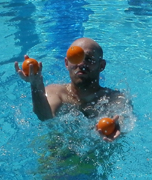
(For the photo above this swim student was in 14 foot deep water. He had lots of experience treading water and juggling so this first try at doing both at once was relatively easy for him.)
Hmmmmm, and learning to juggle can improve your brain
Tips for learning to juggle are at: https://www.wikihow.com/Juggle
You can try this at home with rolled-up pairs of socks.
____________________________
There is potential extra credit for a truly complete (in the opinion of your instructor) journal.
See: Knes 1A novice swim.
Knes 1B beginning swim
Knes 1C intermediate swim
KNES 1D advanced swim
KNES 2A aerobic swim

